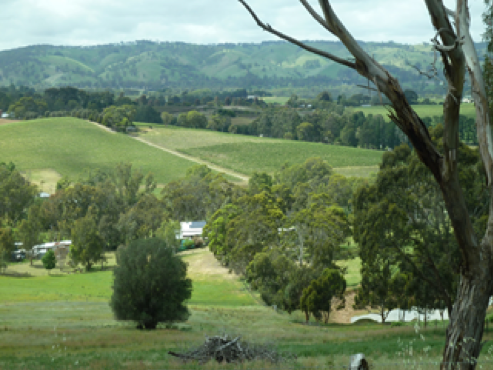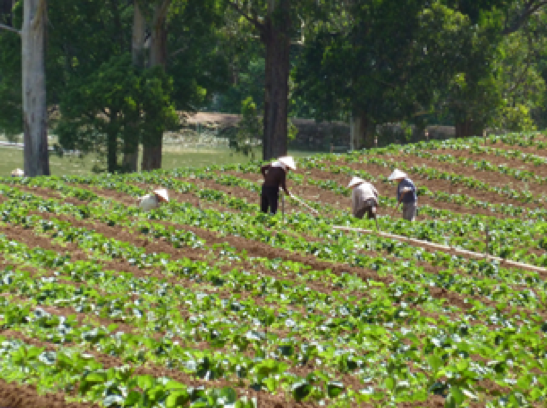As readers of Living Landscape Observer, you may wonder why rural landscape principles are necessary. After all, rural landscape was a category of interest in the World Heritage Convention (Art. 1 and 2) in 1972, but it had become too general as more precise understandings of the meanings of ‘landscape’, ‘nature’ and ‘environment’ evolved. They were often seen as separate concepts. Accordingly, UNESCO introduced the concept of landscapes at a global level in 1992 in part as a substitute for the more generic term ‘site,’ which was a descriptor in the World Heritage Convention (UNESCO 2016)
The term ‘cultural landscapes’ replaced rural landscapes without explanation in the revised Operational Guidelines for the World Heritage Convention in 1992 and was defined as cultural heritage with three sub-categories: ‘designed landscapes,’ ‘continuing landscapes’, and ‘associative landscapes.’ Since then, the cultural landscapes ‘continuing landscapes’ category has included rural landscapes even if the latter were not explicitly mentioned in the definition.
The need for a systematic approach to classification, evaluation and management since the 1990s has led to thematic studies of landscapes involving pastoralism, specific crop production like rice and wine grapes, vernacular rural villages, oases, and the Food and Agricultural Organisation’s Globally Important Agricultural Heritage Systems (GIAHS) primarily dedicated to maintaining site-specific technical traditions and agricultural knowledge systems tied to rural locations. But ‘landscape as heritage’ needs a common thread to bind protection based on methodology and awareness of the value of rural landscapes each with its particularities, traditions and sustainable usage. The World Rural Landscape Principles were developed to fill this need and the preamble states that:
‘Rural landscapes are a vital component of the heritage of humanity. They are also one of the most common types of continuing cultural landscapes. There is a great diversity of rural landscapes around the world that represent cultures and cultural traditions… They provide multiple economic and social benefits, multifunctionality, cultural support and ecosystem services for human societies’ (ICOMOS 2017a).

Definitions
‘Rural landscapesare terrestrial and aquatic areas co-produced by human-nature interaction and within which renewable natural resources are produced, such as food and/or raw materials. At the same time rural areas have cultural meanings attributed to them by people and communities.
Rural landscapes are dynamic, living systems encompassing places produced and managed through traditional methods, techniques, accumulated knowledge, and cultural practices, as well as those places where traditional approaches to production have been recently changed.
Rural landscapes encompass both well-managed and degraded or abandoned areas that can be reused or reclaimed. They can be huge rural spaces, peri-urban areas as well as small spaces within built-up areas. Rural landscapes encompass land surfaces, subsurface soils and resources, the airspace above, and water bodies.’
There is an implicit distinction between ‘rural’ and ‘agricultural.’ Agricultural activity is historically focused on sedentary food production accounting for scientific debates and terminology which have enlivened historical, geographical and agronomic studies on the question of agriculture and rurality. The term ‘rural’ acts as an umbrella concept in the context of the Principles to clearly articulate the types of production activities besides agriculture that developed through the centuries in the various areas of the world, such as aquaculture and fishing, different kinds of animal husbandry, forestry management, hunting, natural product harvesting, extraction and working of shared resources such as salt. these activities has given rise to specific landscapes.
Landscape is understood as the co-presence of physical features and of meanings attributed to them. ‘At the same time, all rural areas have cultural meanings attributed to them by people and communities.’ (ICOMOS 2017a) Rural activity creates rural spaces which can be read through the lens of landscape concepts, underlining both the physical characteristics and the multiple cultural values (aesthetic, historical, social, spiritual, economic, scientific) attributed to them.

‘Rural landscape heritage:Refers to the tangible and intangible heritage of rural areas. Rural landscape heritage encompasses physical attributes – the productive land itself, morphology, infrastructure, vegetation, settlements, transport, and trade networks, etc. – as well as wider physical, cultural, and environmental linkages and settings. Rural landscape heritage also includes associated cultural knowledge, traditions, practices, expressions of local human communities’ identity and belonging, and the cultural values and meanings attributed to those landscapes by past and contemporary people and communities. Rural landscapes encompass technical, scientific, and practical knowledge, related to human-nature relationships. Rural landscapes are expressions of social structures and functional organizations, realizing, using and transforming them, in the past and in the present. Rural landscape heritage encompasses cultural, spiritual, and natural attributes that contribute to the continuation of biocultural diversity. Rural landscape heritage can be found in all rural areas, both outstanding and ordinary, traditional and recently transformed by modernization activities, although in different degrees and types and related to many historic periods, as a palimpsest.’

The second definition of ‘rural landscapes as heritage’ defines the concept of heritage in conjunction with the concept of landscape. The attributes of heritage, its ‘biocultural diversity’ characterise a rural area and form one of its fundamental corner-stones.
These concepts expressed in the Principles in the two definitions represent a strongly innovative declaration compared to the traditional political vision of heritage protection based on choosing specific areas for their exceptional qualities. These areas may range from a conservation area national park without considering its buffer zone to areas of productive rural use. However, this view is no longer effective or useful especially given the common over-simplification splitting productive rural areas into two categories: those related to industrialised production having lost any historical memory or heritage value, and those related to areas where any remaining traditional activity is viewed as a sanctuary of precious values at risk of disappearing forever. This binary view ignores the many types of rural activity that exist in the landscape and are worthy of consideration for protection.
You might like to consider a range of rural landscapes with differing values from your own experience. The next issue will discuss threats to the heritage values of rural landscapes.
References:
ICOMOS, 2017a. “ICOMOS-IFLA Principles Concerning Rural Landscapes as Heritage”. https://www.icomos.org/images/DOCUMENTS/
Charters/GA2017_6-3-1_RuralLandscapesPrinciples_ EN_adopted-15122017.pdfUNESCO, 2016. Operational Guidelines for the implementation of the World Heritage
Convention, Annex 3, UNESCO World Heritage Centre, Paris.
Jane Lennon is an historical geographer with a PhD on cultural landscape conservation; she is a founding member of Australia ICOMOS, adjunct professor at Deakin University, honorary professor at the University of Melbourne specialising in heritage landscapes and has published extensively. She has long experience in national park, museum, historic site management, heritage boards including the Australian Heritage Council, ICCROM and the ICOMOS/IFLA International Scientific Committee on cultural landscapes


